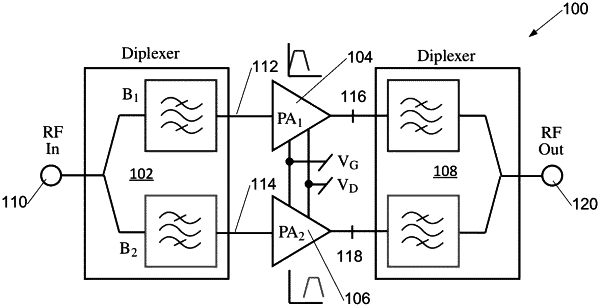| CPC H03F 3/245 (2013.01) [H03F 1/56 (2013.01); H04L 5/1438 (2013.01); H04L 25/08 (2013.01); H03F 2200/165 (2013.01); H03F 2200/171 (2013.01); H03F 2200/451 (2013.01)] | 22 Claims |

|
1. A wideband amplifier configured to receive a broadband input signal and provide an amplified broadband output signal comprising:
a first multiplexer coupled to receive the broadband input signal and to divide the broadband input signal by frequency into a first-band input-signal and a second-band input-signal, the first-band input-signal having a lower frequency band than the second-band input-signal;
a first band amplifier coupled to amplify the first-band input-signal and provide a first band output signal;
a second band amplifier coupled to amplify the second-band input-signal and provide a second band output signal; and
a second multiplexer coupled to combine the first band output signal and the second band output signal into the amplified broadband output signal;
wherein: (i) a frequency range of the first-band input-signal overlaps a frequency range of the second-band input-signal in a transition region; and (ii) a frequency range of the first band amplifier overlaps a frequency range of the second band amplifier in the transition region;
wherein, for frequencies in the transition region, a first signal path through the first multiplexer, the first band amplifier, and the second multiplexer has a first group delay matching a second group delay of a second signal path through the first multiplexer, the second band amplifier, and the second multiplexer; and
the second multiplexer is configured to sum the first band output signal with the second band output signal to provide gain in the transition region.
|